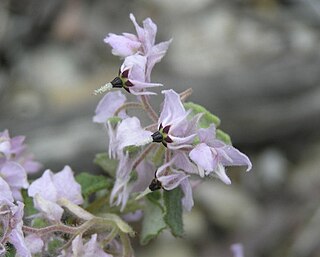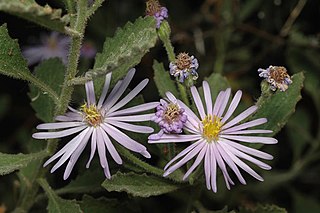
Thomasia tenuivestita is a species of flowering plant in the family Malvaceae and is endemic to the south-west of Western Australia. It is a shrub with its new growth covered with greyish, star-shaped hairs, and has egg-shaped leaves, and racemes of mauve flowers.

Lasiopetalum maxwellii is a species of flowering plant in the family Malvaceae and is endemic to the south coast Western Australia. It is a sprawling shrub with hairy young stems, lance-shaped to oblong leaves and white to cream-coloured flowers.

Thomasia quercifolia, commonly known as oak leaved thomasia, is a flowering plant in the family Malvaceae and is endemic to the south-west of Western Australia. It has egg-shaped, lobed leaves with a heart-shaped base, and pink to mauve flowers.

Lasiopetalum floribundum, commonly known as free flowering lasiopetalum, is a species of flowering plant in the family Malvaceae and is endemic to the south-west of Western Australia. It is an erect or spreading shrub with hairy young stems, egg-shaped leaves and pale pink, mauve or white flowers.
Lasiopetalum cardiophyllum, is a species of flowering plant in the family Malvaceae and is endemic to the south-west of Western Australia. It is an erect shrub with egg-shaped to heart-shaped leaves and groups of pinkish flowers.

Lasiopetalum drummondii is a species of flowering plant in the family Malvaceae and is endemic to the south-west of Western Australia. It is an erect, slender shrub with many densely hairy stems, egg-shaped or oblong leaves and white, pink and red flowers.

Lasiopetalum glabratum is a species of flowering plant in the family Malvaceae and is endemic to the south-west of Western Australia. It is an erect shrub with densely hairy young stems, egg-shaped leaves and pale mauve-pink reddish-purple flowers.

Lasiopetalum glutinosum is a species of flowering plant in the family Malvaceae and is endemic to the south-west of Western Australia. It is a spreading, multi-stemmed shrub with densely hairy young stems, egg-shaped leaves often with three lobes and bright pink or dark red flowers.
Lasiopetalum lineare is a species of flowering plant in the family Malvaceae and is endemic to the south-west of Western Australia. It is an erect shrub with densely hairy young stems, linear leaves and bright pink and dark red flowers.
Lasiopetalum membranaceum is a species of flowering plant in the family Malvaceae and is endemic to near-coastal areas of south-western Western Australia. It is an erect, spreading shrub or subshrub with hairy young stems, egg-shaped leaves and mauve-pink and dark red flowers.

Lasiopetalum molle, commonly known as soft leaved lasiopetalum, is a species of flowering plant in the family Malvaceae and is endemic to the south-west of Western Australia. It is an erect or spreading subshrub or shrub with hairy stems, thick and stiff egg-shaped leaves and pink flowers.

Lasiopetalum ogilvieanum is a species of flowering plant in the family Malvaceae and is endemic to the south-west of Western Australia. It is an open, spindly or rounded shrub with rusty-hairy young stems, narrowly egg-shaped to narrowly elliptic leaves and white or pink and dark red flowers.

Lasiopetalum oldfieldii is a species of flowering plant in the family Malvaceae and is endemic to the south-west of Western Australia. It is a low, spreading shrub with rusty-hairy young stems, egg-shaped to narrowly egg-shaped leaves and pink and dark red flowers.

Lasiopetalum oppositifolium is a species of flowering plant in the family Malvaceae and is endemic to the south-west of Western Australia. It is an open, erect shrub with rusty-hairy young stems, linear, narrowly elliptic or narrowly egg-shaped leaves and white, pink and dark red flowers.

Lasiopetalum parvuliflorum is a species of flowering plant in the family Malvaceae and is endemic to the south-west of Western Australia. It is an erect, spreading shrub with hairy stems, oblong to linear leaves and green or cream-coloured flowers.

Lasiopetalum rotundifolium is a species of flowering plant in the family Malvaceae and is endemic to the south-west of Western Australia. It is an erect to spreading shrub with hairy young stems, round leaves with a heart-shaped base, and pink and dark red flowers.
Lasiopetalum × tepperi is a species of flowering plant in the family Malvaceae and is endemic to the south-east of South Australia. It is an erect, spreading or sprawling shrub with hairy stems, egg-shaped to lance-shaped leaves and pink flowers.

Lasiopetalum trichanthera is a species of flowering plant in the family Malvaceae and is endemic to a restricted area in the south-west of Western Australia. It is an erect to straggling, sticky shrub with many hairy stems, egg-shaped leaves and bright pink and dark red flowers.

Olearia xerophila is a species of flowering plant in the family Asteraceae and is endemic northern Australia. It is an erect subshrub with elliptic to broadly elliptic leaves and violet, blue or mauve and yellow, daisy-like inflorescences.

Commersonia magniflora is a species of flowering plant in the family Malvaceae and endemic to Australia. It is an erect shrub with wrinkled, narrowly oblong to elliptic or egg-shaped leaves, and deep pink flowers.
















